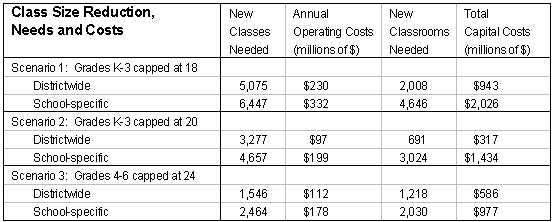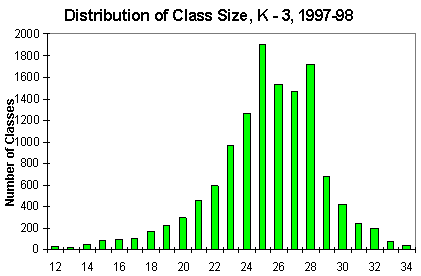

Class size reduction has recently received much attention from education advocates and public officials. In the city, the Board of Education (BOE) is planning to implement a new state initiative next year which will pay for reducing some-but not all-early grade classes to 20 students.
At the request of Public Advocate Mark Green, IBO has studied current class sizes across the city and estimated the cost to the city of reducing all kindergarten through third grade (K-3) classes to 20 students or less. The study also examined the costs of reducing K-3 classes to no more than 18 students and grades 4 through 6 to a maximum of 24 students.
As shown below, IBO found that depending on how such an initiative were implemented, the city's annual operating costs for capping K-3 classes at 20 students would range from $97 million to $199 million. These costs are above the $146 million in operating funds the city expects to receive from the state once the law is fully implemented. Total capital costs would range from $317 million to $1.4 billion beyond the state allocation of $10,000 per classroom in capital funds for class size reduction.
There are wide differences in class sizes across the city. Brooklyn's District 17 has the most crowded kindergartens with an average class size of 25.9, compared with 23.9 in all city kindergartens. In the first and second grades, Queens Districts 27 and 29 each had average class sizes well over the citywide average of 25.3. Third grade average class sizes range from 20.3 in Manhattan's District 1 to 27.7 in Brooklyn's District 17, while the citywide average is 25.9.
Another way to assess class size is to look at the number of classes that have more than the average number of students. Sixty-five percent of all K-3 classes have 25 or more children and 13 percent have 29 or more. Fifty-seven percent of grade 4-6 classes have 29 or more children and 16 percent have 33 or more.
Reducing class sizes will require that BOE add new classes, hire new teachers, and in some cases, build new classrooms. The exact number of new classes and classrooms depends on how a class size reduction program is implemented. New classes require additional annual operating expenditures. New classrooms require a capital investment.
IBO estimated these costs using two scenarios. The first, a districtwide approach, supposes that districts use all their available space, even when this requires assigning some children to a different school. The second, a school-specific approach, supposes that new classes and classrooms are added at the schools that need them, even if there is unused capacity elsewhere in the district. Currently there are 13,261 classes for K-3 and 7,767 for grades 4-6.
The full report, The Cost of Reducing Class Size, is available on the IBO website or by calling (212) 442-0632.

